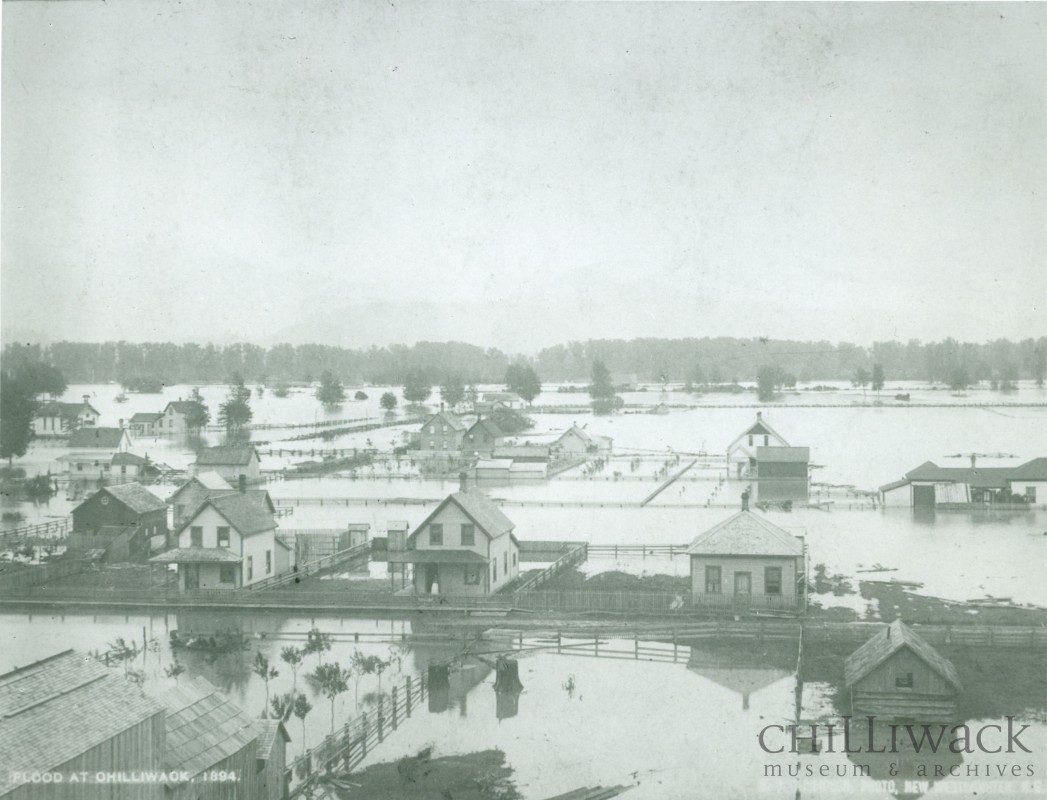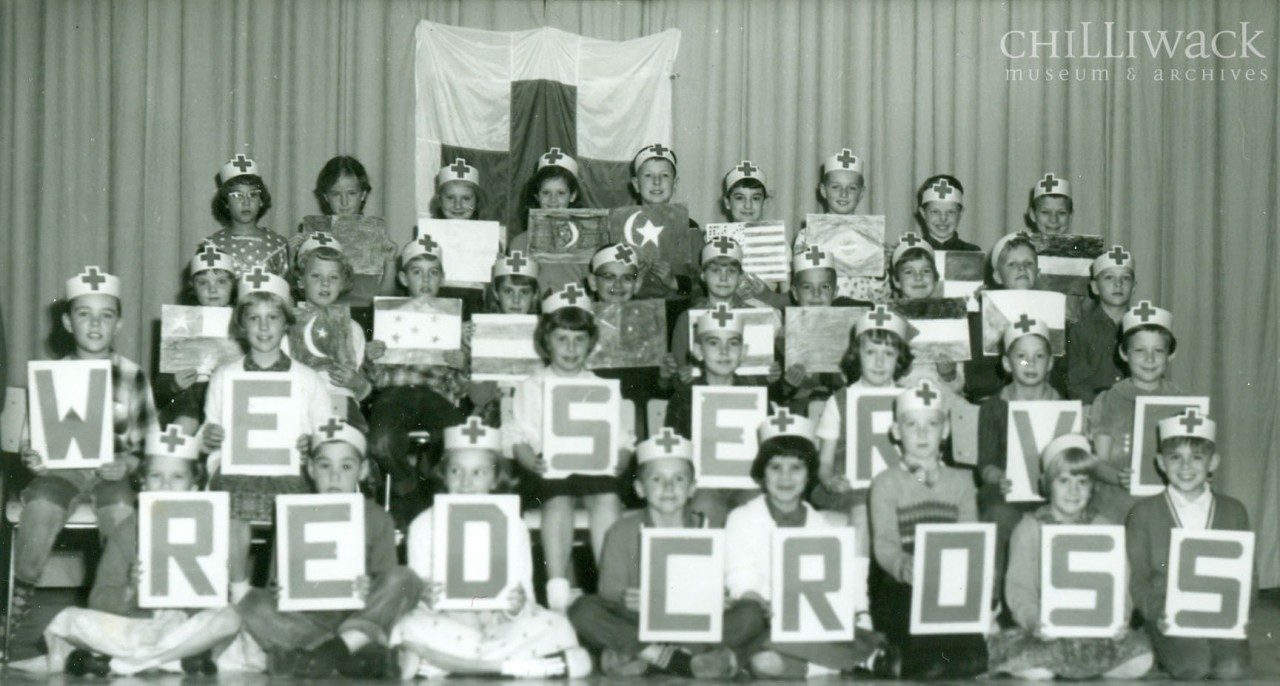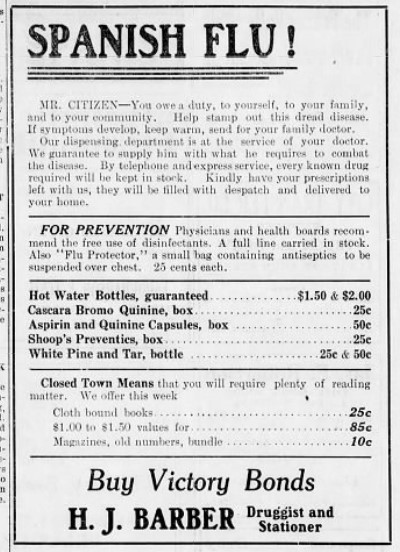With the COVID-19 pandemic constantly evolving, life is shifting rapidly these days. As borders close, facilities shutter and services reduce in the community, an eerie feeling can be felt over the streets. Life feels as though it is coming to a standstill, especially as the calls to stay indoors and self-isolate become stronger. The urge to do something – anything – is high.
Every crisis is different, as is every response. Over time, Chilliwackians have collaborated, solving crises together and tackling challenges with appropriate levels of generosity, consideration and resiliency.

Photograph of Chilliwack during the 1894 flood showing the area that is now Main Street and Yale Road West. [Chilliwack Museum and Archives, 1973.034.010]
In Crisis: Flooded With Kindness
When disasters like the 1894 flood happened, communities like Chilliwack banded together to support our neighbours. When the Mission gauge on the Fraser River reached 25.75 feet on June 6, the floodwaters covered many of our streets, submerging hundreds of hectares of farm land and Five Corners. As all communication with New Westminster was unavailable and the floodwaters left residents stranded, The Chilliwack Progress reported that Chilliwack’s Mayor Samuel Cawley “advised the taking of a row boat and making at once to [New] Westminster for the purpose of obtaining aid.” He, along with a crew of four men, rowed down the Fraser River, taking approximately five hours to arrive at New Westminster. The men procured the Gladys, a steamer, and brought her up the Fraser River with the hopes of having the vessel assist with saving livestock and anyone unable to save themselves.

Photograph of grade three students at Central Elementary taking part in a Junior Red Cross rally in 1962. Chilliwack has a long history of supporting each other in times of need. [Chilliwack Progress Press Photograph, May 16, 1962. Chilliwack Museum and Archives, 1999.029.021.057]
At War: Stitching It Together
In times such as World War One, Chilliwackians embraced wartime efforts led by groups such as the Sardis Red Cross Sewing Circle. The group, which crafted a handmade red and white quilt in 1918 and embroidered the names of Chilliwackians who donated ten cents, donated all profits to the war effort. Approximately 400 names are contained on the quilt, which was then raffled off and won by A.C. Wells. At the Chilliwack Museum and Archives, the quilt [1972.035.001] serves as a proud reminder of our community coming together to support a cause larger than itself.
Staying Apart: Influenza of 1918
As we are seeing today with COVID-19, pandemics can bring life to a screeching halt. While different, the 1918 influenza pandemic did just that in Chilliwack in 1918. The flu spread rapidly, transmitting between people primarily through airborne particles shared through sneezing and coughing. Soldiers returning home from war compounded the spread.

Advertisement published in the Chilliwack Progress by H.J. Barber (druggist) in November 1918.
Acting upon orders issued by the Provincial Board of Health, the Municipality of Chilliwhack and the City of Chilliwack closed all gathering spaces to fight the spread of the virus indefinitely in October 1918. All churches, theatres, schools and various gathering spaces such as pool halls were closed to the public for a period of a few months. To cope with the hundreds of cases, Coqualeetza Institute was transformed into an emergency hospital.
During the “flu ban,” Chilliwackians worked together by staying apart. Begrudgingly accepting the conditions of the ban, local churches like Saint Thomas Anglican Church cancelled public services, instead encouraging local parishioners to continue prayer and meditation at their regular hours at home when the bells were sounded. Meetings were cancelled, demonstrations postponed and theatrical performances indefinitely put on the backburner. Individuals who fell sick were to report their illness to J.C. Henderson (Medical Health Officer) immediately: failure to do so was grounds for prosecution. Following illness, a minimum of ten to fifteen days of self-isolation was prescribed.
After a closure of multiple weeks, life slowly began to normalize. City and municipal operated works re-opened on November 17 and the ban on gatherings was lifted. While multiple deaths were attributed to the outbreak, Henderson noted the death rate was low, no doubt due to actions taken to contain the spread.
Of Our Time: COVID-19
It is tempting to draw parallels between the 1918 influenza outbreak and what we see unfolding before us today.
We are in the early days of this pandemic. We do not know what will happen. What we do know for certain is that following the lead of our medical professionals has led our communities back to health before. We also know that history has shown Chilliwackians are resilient: when life has thrown us curveballs, we have adapted to the situation and persevered with a constant eye to protecting our community members.
As in the past, we are asked to come together by staying apart. This can be challenging for us – we are social beings. We want to be with people: to be with our loved ones in care homes, to celebrate birthdays, to catch up with friend groups and go to concerts. Please don’t.
Like the influenza of 1918, COVID-19 will pass eventually. It will be in its own way and will be in its own time but what we are living through right now will end. Life will normalize.
Stay strong. Come together – but stay apart.

Comments are closed.